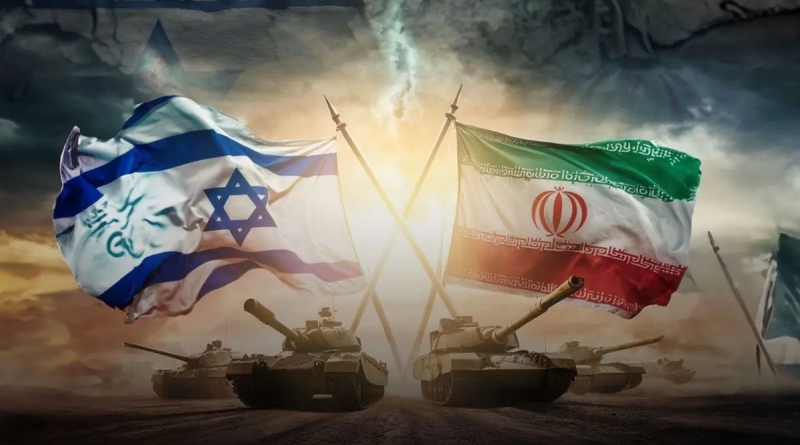Why Iran Wants Israel Gone: Roots of Iran’s War on Israel
It is the regime in Tehran that refuses to join any table where Israel is present. At its core, this is a grand strategy rooted—as is often the case—in identity politics.
In Western media, it’s common to describe Israel and Iran (more precisely, the current regime in Tehran) as each other’s “main enemy” or “arch-enemy.” The term echoes Cold War-era Soviet rhetoric and seems to reflect a reality of deep-rooted geopolitical rivalry. But the hostility between Israel and Iran is neither ancient nor inevitable. As regional powers, some degree of competition between them is natural—especially in an era of American retreat—but that alone doesn’t explain why the destruction of Israel has become a clear and central objective of Iran’s grand strategy since the Islamic Revolution.
This wasn’t the case under the previous regime. As many Israelis know—and sometimes remind others, though the topic has become sensitive due to long-standing legal disputes over unresolved financial issues—there’s an almost monumental “memorial” in Israel to the cooperation and once-strong friendship between the two countries. It’s about 200 kilometers long and occasionally leaks: the Eilat-Ashkelon oil pipeline was originally built to transport Iranian oil to the Mediterranean Sea, and from there to European ports. Until the Islamic Revolution and Khomeini’s rise to power, Iran was a strategic partner of Israel and a member of the “periphery alliance” that Ben-Gurion forged in the late 1950s in response to the Nasserist threat, alongside Kemalist Turkey and imperial Ethiopia (both of which have also undergone major changes since then). Israelis were involved in various projects in Iran, from security to agriculture.
So what lies at the root of this intense hostility toward Israel’s very existence, which has become—literally—one of the regime’s core ideological principles, both for Khomeini and his successor as Supreme Leader (Rahbar—“Guide,” a title whose meaning becomes especially clear if translated into German…) Ali Khamenei? Anger over the role Israel and the U.S. played in supporting the hated Shah regime is certainly part of the initial explanation. But past grievances alone don’t account for the depth and persistence of this enmity, which just recently found renewed expression in bold statements about the commitment to destroy Israel (“even if we are cut to pieces,” in the words of a senior Revolutionary Guards commander). Far more powerful forces, rooted in the very identity of the Iranian revolutionary regime, are at play here.
The Iranian revolutionary regime could have, if it had wanted to, used the arms supply from Israel—part of the problematic Iran-Contra deal in the Reagan era—as a springboard to open a new chapter. It chose not to. On the contrary, the hostility only deepened and intensified over time. It even took on the grotesque form of mocking the Holocaust—through cartoon contests that continued even after the Ahmadinejad era—and was succinctly expressed in a venomous tweet by Khamenei in November 2014 (still available online), detailing nine points explaining why and how Israel should be eliminated.
Traditional geopolitics naturally breeds competition and sometimes conflict between regional powers. But in this case, it fails to justify such an extreme stance—unparalleled in today’s international arena—where one UN member state denies the very right of another to exist. It also doesn’t justify Iran’s massive investment in arming Hezbollah to seriously threaten Israel’s civilian rear; in arming and training Palestinian terrorist groups through its cooperation with Hamas and its proxy ties with Palestinian Islamic Jihad; or in turning Assad’s Syria into a land bridge to the Mediterranean and an additional launchpad for attacks on Israel.
It’s true that Iran’s leadership today, through this “ring of fire,” also has a deterrent motive: to discourage Israel from launching a military strike on its nuclear weapons program. But Israel, for its part, would not be considering such a strike had Iran not openly marked it for destruction and forced Israel to treat the Iranian regime as a threat to its very survival. So what, then, fuels the constant chant of “Death to Israel” — “Marg bar Israel”?
There’s no territorial dispute between Israel and Iran, nor economic rivalry—aside from the unresolved question of compensation for the oil pipeline, currently under arbitration in a Swiss court. Israel does not threaten Iran’s legitimate demand to be part of the regional power balance and to sit at the diplomatic table. It is the regime in Tehran that refuses to join any table where Israel is present. At its core, this is a grand strategy rooted—as is often the case—in identity politics. In this instance, the identity of the current Iranian regime as a political embodiment of a sweeping, dramatic, modern, and revolutionary interpretation of Shiite Islamic doctrine.
It’s worth recalling: the fundamental split between Sunnis (literally “people of the tradition”) and Shiites (“the faction”) stems from a disagreement about the political history of the Muslim community—who should have succeeded the Prophet Muhammad as spiritual leader, political head, and military commander. The Shiites remained loyal to Ali, the Prophet’s son-in-law, and his direct descendants. The deaths of the Prophet’s grandsons, Hasan and Husayn (Ali’s sons), in their defeat against the Sunni Umayyad dynasty’s army at the Battle of Karbala (680 CE), became in Shiite theology a formative catastrophe—a triumph of injustice and the symbol of a history that went terribly wrong.
In the end times, this wrong is to be righted with the return of the “Hidden Imam.” Iranian Shiism belongs to the Twelver branch, which recognizes ten generations of Ali’s descendants until the disappearance of the last one—Muhammad, son of Hasan al-Askari—in 874 CE. Since then, Twelver Shiites await his return. When he reappears as the Mahdi—a figure somewhat comparable to the Jewish Messiah—the world will be redeemed. But according to the interpretation that Khomeini introduced in the last quarter of the 20th century, the prolonged mourning for that loss and the patient wait for redemption were replaced by a call to arms: to rally believers to active struggle, and to fix the world by force.
What Khomeini effectively did—and he was likely influenced during his exile in Paris by thinkers like Frantz Fanon and others who framed anti-colonial, anti-Western Marxist struggles in the Third World as redemption for “the wretched of the earth”—was to translate the ancient anguish and frustration of Shiism into a modern revolutionary agenda. The injustice of the 7th century thus became, in its Khomeinist reincarnation, a call to overturn the existing local, regional, and global political order.
It so happened that the Islamic Revolution’s rise to power in Iran occurred the same year that a cornerstone of secular Arab nationalism collapsed: the peace agreement signed by Egypt’s President Sadat with Israel in March 1979 on the White House lawn—just weeks after Khomeini’s return to Iran in triumph. This coincidence created another twist in Iran’s stance toward Israel, which has grown increasingly rigid and defiant over four decades. The core message: first Egypt, and later (in the 1990s) other weak and “treacherous” Sunni regimes, surrendered to Israel and laid down their arms—or, as Saddam did in 1981, turned them against Iran. Not coincidentally, Iran’s regime named a major Tehran street after Khaled al-Islambouli, Sadat’s assassin.
Now, it is supposedly the duty of “true Islam”—the Shiite version of revolutionary Islamism—to prove its worth and moral superiority by being the only one to persist in striving for Israel’s destruction. For this goal, the Iranians were willing to overcome, in the name of unity against a common enemy, the deep gulf between Shiism and radical Sunni groups like Hamas and Palestinian Islamic Jihad. Still, the Sunni-Shiite divide re-emerged in Iraq after the U.S. invasion in spring 2003. Iran sees ISIS as an existential enemy of Shiism and contributed to its defeat in Iraq and Syria, yet this shared interest with the U.S. didn’t shift Tehran’s fundamental positions.
In any case, even as it is entangled in multiple fronts, the ayatollahs’ regime views the struggle to destroy Israel as a central part of its historic mission. To its mind, this is definitive proof that the Shiite revolution—according to its interpretation—is the true fulfillment of Islamic commandment. Meanwhile, the “wretched” Sunni regimes have surrendered, accepted Israel’s existence, and even normalized ties. It’s important to note that Iran has very complex relations with the UAE: a territorial dispute—it controls three islands belonging to the Emirates—combined with ideological tensions, yet also diplomatic dialogue and extensive trade and financial relations.
Iran’s position toward Israel has therefore become, in the eyes of its leadership, a source of regime legitimacy—both across the Sunni Muslim world and, even more crucially, at home. After all, the revolution has failed in practice when it comes to the wellbeing of the Iranian people. A country that was three times richer than Turkey in 1979 is now four times poorer. Corruption, drugs, and prostitution have infected the social fabric. Brutal repression of dissent has become routine. Precisely because of this, the regime stakes its credibility on waving the anti-Zionist flag with fervor. It’s not at all clear that this stance enjoys broad public support, especially given public resentment over massive expenditures in Syria and Lebanon. But it does tighten the regime’s grip on its core political base—the religious establishment.
Moreover, by its very existence, Israel—as a modern nation-state with Western features, not merely a “protected community” like Iranian Jews—embodies a central pillar of the post-1945 global order. In its ideological horizon, the Shiite totalitarian revolution seeks to upend this order entirely. It defines it in terms of “hegemony” and “global arrogance” (a code name for the U.S.) and links the struggle against it to the fight against “the Great Satan” in Washington and “the Little Satan” in Jerusalem. At one point, Ahmadinejad even tried to offer his German hosts condolences for losing WWII—suggesting that, in his view, the wrong side won. In this context, the intent to destroy Israel is indeed part of a comprehensive, strategic, ideological, and historical worldview aimed at fixing what went wrong in 661 (Ali’s assassination), 680 (his sons’ deaths at Karbala), and 1945 and 1948.
Despite occasional shows of tolerance toward Iran’s relatively large remaining Jewish community, this worldview also contains unmistakable notes of classic anti-Semitism, which have seeped into Iranian discourse under the influence of Western totalitarian models.
The implication for Israel, its friends, allies, and new regional partners should be clear. Unlike “ordinary” conflicts over clashing interests, these meta-historical motivations are powerful. It’s hard to change or deter them through diplomacy—unless that diplomacy is backed by strong, effective military deterrence.
Translated in English from Jerusalem Institute of Strategic Studies.



